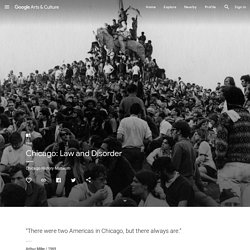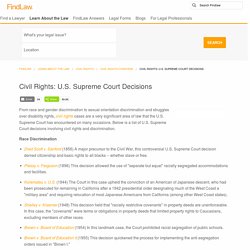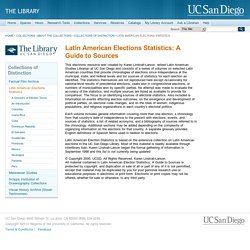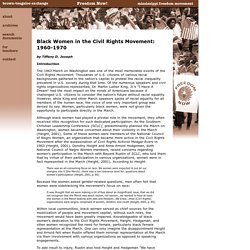

Chicago: Law and Disorder - Chicago History Museum. **If you see any work in this exhibition that infringes your intellectual property rights, please contact the Chicago History Museum (alter@chicagohistory) for a Takedown Notice.

Alternatively, you can send a Takedown Notice to alter@chicagohistory.org, using the template below. Please fill in the details of the specific work appearing in the exhibit. RE: Copyright Claim To: Peter Alter, Chicago History Museum (alter@chicagohistory.org) I am the copyright owner of the (insert type of work) being infringed in Chicago 1968 on the Google Cultural Institute Platform. I have good faith belief that use of the material in the manner complained of here is not authorized by me, the copyright holder, and that there is no legal basis for the use of these materials. Please send me, at the address noted below, a prompt response indicating the actions you have taken to resolve this matter. Brown v board of education. Civil Rights: U.S. Supreme Court Decisions - FindLaw. From race and gender discrimination to sexual orientation discrimination and struggles over disability rights, civil rights cases are a very significant area of law that the U.S.

Supreme Court has encountered on many occasions. In revolutiejaar 1968 kookte het overal, maar veranderde er weinig. Belangrijke wijziging voor toestemming voor cookies voor Advertenties en Social Media De websites van de Nederlandse Publieke Omroep maken gebruik van cookies.

Deze cookies onderscheiden we in de categorieën functionele, analytische, advertentie en Social Media Cookies. Advertentie en Social Media Cookies verzamelen gegevens over de activiteiten van individuele gebruikers. Hiermee wordt door derde partijen, zoals adverteerders, gegevens verzameld om op jou afgestemde advertenties te kunnen tonen. Door gebruik te blijven maken van deze website geef je toestemming voor het plaatsen van deze cookies. Klik hier voor meer uitleg Waarom cookies? De Nederlandse Publieke Omroep plaatst specifieke cookies om het gebruiksgemak voor bezoekers te vergroten.
Hiermee kunnen we de bezochte website zo gebruiksvriendelijke en interessant mogelijk maken voor de bezoeker. NPO functionele-, Analytics- en Aanbevelingscookies. Latin American Elections Statistics. This electronic resource was created by Karen Lindvall-Larson, retired Latin American Studies Librarian at UC San Diego and consists of a series of volumes on selected Latin American countries that provide chronologies of elections since independence at the municipal, state, and federal levels and list sources of statistics for each election as identified.

The statistics themselves are not reproduced here except occasionally for national-level results of presidential elections, seats won in congressional elections, or numbers of municipalities won by specific parties. No attempt was made to evaluate the accuracy of the statistics, and multiple sources are listed as available to provide for comparison. Freedom Now! Student Work - Tiffany Joseph. Introduction The 1963 March on Washington was one of the most memorable events of the Civil Rights Movement.

Thousands of U.S. citizens of various racial backgrounds gathered in the nation's capital to protest the racial inequality prevalent in U.S. society during that time. Of the numerous speakers and civil rights organizations represented, Dr. Martin Luther King, Jr.'s "I Have A Dream" had the most impact on the minds of Americans because it challenged U.S. citizens to consider the nation's future without racial equality. Although black women had played a pivotal role in the movement, they often received little recognition for such dedicated participation. There was an all-consuming focus on race. Because the women asked gender-related questions, men often felt that women were sidetracking the movement's focus on race: To add insult to injury, Rustin also told Height and Hedgeman "We have Mahalia Jackson" (Height, 2001). Chapter 1: Social Movement Theory and the Civil Rights Movement. Freedom Rights: New Perspectives on the Civil Rights Movement.
I’m a bit brown. But in America I’m white. Not for much longer. We live in a weird time for whiteness.

But, before I get into that, a small disclaimer. You may look at my name and worry that I am unqualified to speak about whiteness; I would like to set these doubts to rest and assure you that I myself am a white person. It’s true that, technically speaking, I’m a bit brown but, when it comes to my legal standing, I’m all white. Well, I’m white in America anyway. The US Census Bureau, you see, defines “white” as “a person having origins in any of the original peoples of Europe, the Middle East, or North Africa”. But I may not be able to hang out in that box much longer. Whether our very own check box is a privilege or petrifying is still to be decided. All of this is a little odd. Once upon a time this wasn’t a question that was asked very much in western countries.
Howard Zinn's Personal Philosophy.
Feminism. Counterculture. Hispanic Americans. Native Americans. Protests in the 1960s. Protests in the 1960s These movements include the civil rights movement, the student movement, the anti-Vietnam War movement, the women’s movement, the gay rights movement, and the environmental movement.

Each, to varying degrees, changed government policy and, perhaps more importantly, changed how almost every American lives today. Supporters of these movements questioned traditional practices about how people were treated. Why did black and white children attend separate schools? Why were women prevented from holding certain jobs? In addition, they did not use traditional methods of political activity. Social change movements erupted in the 1960s for several interrelated reasons. During the 1930s, Americans suffered through the Great Depression, the worst economic downturn in U.S. history. By the 1960s, many Americans had come to believe that the federal government had the power and responsibility to protect them from unfair and unjust social forces. Conclusion. United States - The Kennedy and Johnson administrations.